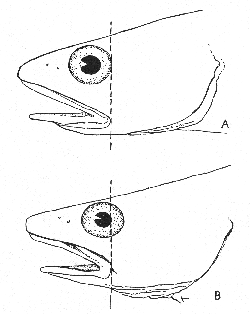White hake Urophycis tenuis (Mitchill) 1815 [25]
BOSTON HAKE; BLACK HAKE; MUD HAKE; HAKE; LING
[Jordan and Evermann, 1896-1900, p. 2555.]

Figure 104.—White hake (Urophycis tenuis), Halifax, Nova Scotia. From Goode. Drawing by H. L. Todd.
Description—
Although the hakes of the genus Urophycis (true hakes in general parlance on this side of the Atlantic) are close relatives of the cod and of the haddock, they are not at all codlike in appearance, being more slender and softer-bodied fish, tapering backward from the shoulders to a slim caudal peduncle and to a small weak tail, with much larger eyes than the cod but with smaller chin barbels. Furthermore, they have only two dorsal fins, the second much longer than the first, and only one anal fin instead of the three dorsals and the two anals of the pollock, cod, and haddock. The ventral fins are, long, narrow, and feelerlike.
The body of the white hake is rounded in front of the vent, flattened sidewise behind the vent, and is about five and one-half times as long as it is deep. The mouth is so large that it gapes back to below the eyes, the upper jaw projects beyond the lower, and the chin bears a small barbel. The first dorsal fin (9 to 10 rays) originates close behind the pectorals, and is shorter [page 222] than the latter, triangular, with the third ray prolonged as a filament that is longer than the fin proper is high. The second dorsal fin (about 54 to 57 rays) runs the whole length of the trunk from close behind the first dorsal fin to the caudal peduncle, is of about equal height from end to end, with rounded corners, and is only about half as high as the first dorsal. The anal fin is similar in outline to the second dorsal but is shorter (about 48 to 50 rays). The pectorals are rounded when spread; the ventral fins are situated considerably in front of the pectorals, and each is reduced to two very much prolonged rays (apparently a single branched ray), with the lower (longer) ray of the two falling slightly short of the vent.
The length of the ventral fins has often been given as an alternative character separating the white hake from the squirrel hake (p. 223), in which the ventrals are usually described as reaching, beyond the vent. This distinction is not to be relied on, however, for we have seen squirrel hakes in which the ventrals lacked something of reaching the vent.
The scales on both head and body are smaller than those of the closely allied squirrel hake, and their number is the most reliable distinction between the two species, there being about 140 oblique rows of scales along the lateral line between gill opening and base of tail fin in the white hake, but seldom, if ever, more than 110 rows of scales in the squirrel hake.
Another difference, which seems equally dependable, though it is less obvious, is that the upper jaw (maxillary) bone reaches as far back as the rear edge of the eye in the white hake, but only as far as the rear edge of the pupil in the squirrel hake.

Figure 105.—Side view of the heads of white hake, A, and of squirrel hake, B, to show the difference between the two in length of the upper jaw bone.
Color—
Like most bottom fish, white hake vary in color. As a rule they are muddy or purple brown above, sometimes almost slaty (we saw one of this shade caught in Northeast Harbor, Maine), the sides sometimes bronzed, and the belly dirty white or yellowish white peppered with tiny black dots. The dorsal fins are of the same color as the back, the anal fin the same as the belly, and both the dorsals and the anal are edged with black. The ventral fins are pale, like the belly, but usually they are more tinged with yellow.
Size—
The maximum length is about 4 feet, the maximum weight about 40 pounds. But most [page 223] of the fish that are caught weigh between 1 and 20 pounds, averaging no more than 8 pounds. A hake 28 inches long will weigh about 8½ pounds if it is in good condition; one of 30 inches, about 9 pounds; 36 to 38 inches, 13 to 16 pounds; and about 18 pounds at 40 inches, according to Welsh's experience.